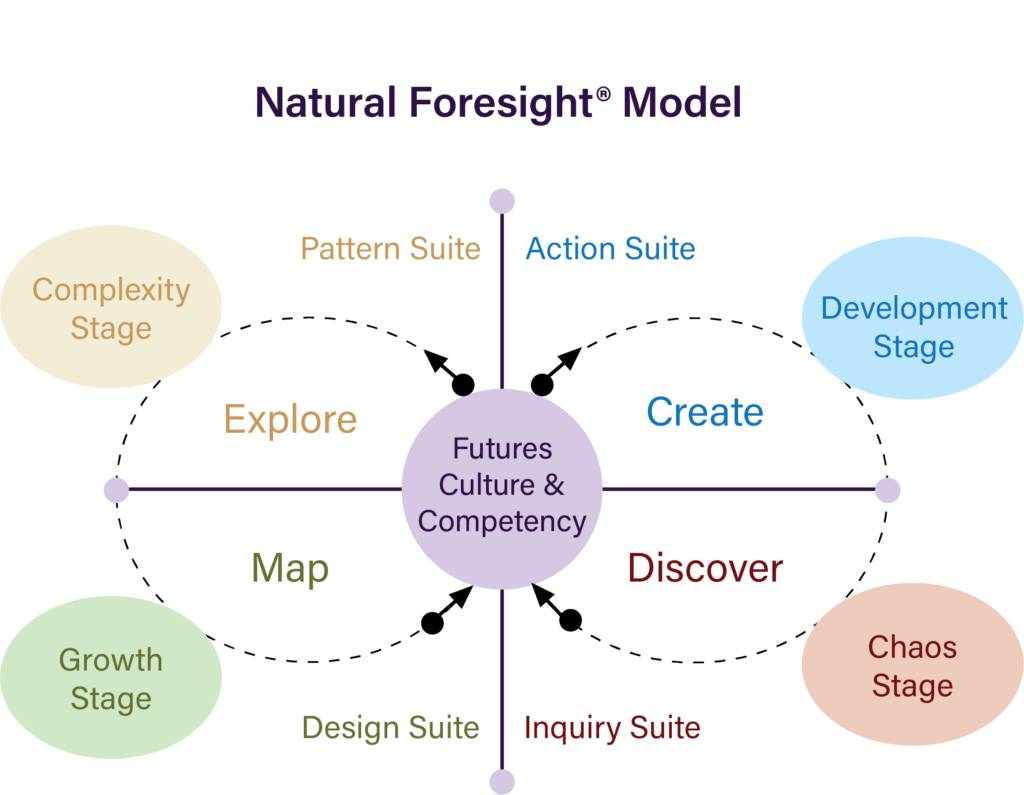Why Natural Foresight® Makes Your Organization Healthier

Here’s a secret about futures thinking and foresight: It should be a natural part of your organizational processes and operations, an organic component of your business culture.
In other words, foresight should naturally flow from organizational design, being just as commonplace and essential to a business as leadership development, human relations, strategy, planning, or talent management.
Yet foresight is often ignored or sidelined in organizational development because we tend to view company-building as a highly quantifiable process, as if we are putting together a clock with multiple cogs and wheels.
Seeing our organizations as machines is a byproduct of our Industrial Age indoctrination, where all processes are treated like an assembly line and every problem is solved by adding the missing part or replacing those that are defective. If that doesn’t work, we often go back to the drawing board in an effort to create a better machine.
This view is extremely tempting. It helps us to mentally simplify our world, schematically defining all of our processes and problems as pieces of an engine that can be fixed with the twist of a screw or the addition of a bolt.
Unfortunately – or maybe fortunately – this just isn’t true. An organization doesn’t resemble nor operate like a machine. It’s more like a living organism.
After all, companies are constructed and formed by the people that work inside of them – living, breathing human beings who are social, complex, and often messy. So how do you get these organic building blocks to function like quantifiable mechanisms? The answer is, you don’t.
You see, at its core, the future is about people.
People are complex, and that complexity is increasing as the growth of information explodes and our world becomes intricately connected. Leaders and executives are now scrambling to adapt.
They know that being future-ready and having a culture of foresight is critical to surviving and thriving in our rapidly changing landscape, so they host workshops on scenario building and planning; they subscribe to various trend banks; and they take foresight assessments to measure their organizational future-fitness.
They may even follow traditional foresight steps in great detail, building maps that describe the next decade.
These endeavors all add up to implementing foresight using industrial age, linear, and machine-like approaches. It makes as much sense as trying to create the first car by adding more horses to a carriage, or building the first airplane by adding more wood and coal to a locomotive.
So what’s the organic approach to foresight?

Natural Foresight® is a model that allows users to approach, understand and implement Futures Thinking and Strategic Foresight in an integrated, holistic and organic fashion.
This means that foresight becomes directly related to what the company is doing, connects to where they are in their growth cycle, impacts organizational culture and development, offers powerful and far-reaching change management, and is viewed as a company-wide competency rather than an isolated segment or initiative.
Natural Foresight leverages the power of traditional foresight tools and practices while helping businesses to connect them to natural and essential elements that make up our everyday real-world experiences such as time frames, organizational growth, culture, learning, leadership development, strategy, and internal/external dynamics.
And because it looks at foresight as a natural process, it adapts to any organization and applies at any part in their processes, allowing users to harness the power of futures and foresight no matter where they are in their journey. In other words, it is not a linear and mechanistic approach to foresight, but rather a model that adapts to the reality of our complex, volatile, and uncertain environments to produce new world innovation, opportunities, and aspirational strategy.
True Natural Foresight is a culture shift.
When seen as a tool, a method, or a set of steps to be followed, foresight is perceived by leadership as just another gimmick that is being added to the “to-do” list of companies and organizations.
It isn’t flowing from their company culture or being practiced as an organizational competency as it should be. And until foresight and futures thinking is no longer viewed as an initiative in your company but rather becomes a natural and organic part of how you do business – helping you to successfully fulfill that “to-do” list – it will never really be deemed critical or implemented, leaving your organization vulnerable to the risks and unaware of opportunities that lay ahead.
If any discipline should understand the need for new models to successfully operate in a new era, it should be Strategic Foresight. Natural Foresight is a fresh approach to the critical skill of foresight for the new normal of the 21st Century.

